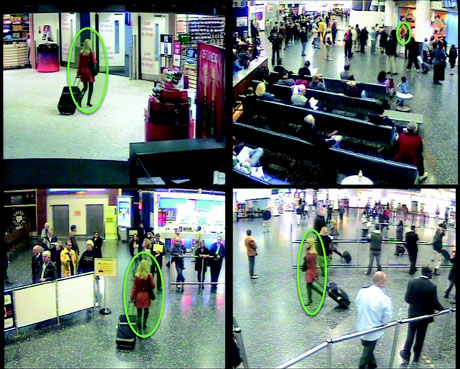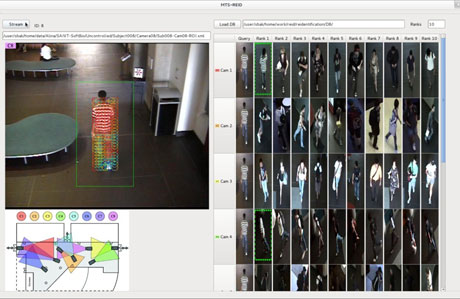by Slawomir Bak and François Bremond
A retrieval tool that helps a human operator browse a network of cameras is being developed at Inria Sophia Antipolis. This tool addresses the problem of person re-identification: determining whether a particular individual has already appeared over a network of cameras.
{jcomments on}Person re-identification (also known as multi-camera tracking) is defined as the process of determining whether a given individual has already appeared over a network of cameras (see Figure 1). This task can be considered on different levels depending on information cues which are currently available in video analytics systems. For instance, biometrics such as face, iris or gait can be used to identify people. However, in most video surveillance scenarios such detailed information is not available due to video low-resolution or difficult segmentation (crowded environments, such as airports and metro stations). Therefore a robust modelling of the global appearance of an individual (clothing) is necessary for re-identification. This is a particularly challenging problem owing to significant appearance changes caused by variations in view angle, lighting conditions and the individual’s different positions.


Owing to this complexity, current state of the art approaches have relatively low retrieval accuracy, thus a fully automated system is still unattainable. However, we propose a retrieval tool that helps a human operator to solve the re-identification task.
Our proposed tool (Figure 2) allows a human operator to browse images of people extracted from a network of cameras: to detect a person on one camera and to re-detect the same person few minutes later on another camera. The main stream is displayed on the left of the screen, while retrieval results are shown on the right. The results show lists of the most similar signatures extracted from each camera (green boxes indicate the correctly retrieved person). Below the main stream window a topology of the camera network is shown. Detection and single camera tracking (see the main stream) are fully automatic. The human operator only needs to select a person of interest, thus producing retrieval results (right screen). The operator can easily see a preview of the retrieval results and can go directly to the original video content.
Our tool is based on novel techniques, which outperform the best state of the art solutions on the market. These techniques allow the identification of a visual signature (comprising a set of covariance matrices of reliable descriptors) characteristic of one individual while being camera invariant and the most discriminative compared to the other observed people [1][2].
We are working not only on re-identification libraries, which provide high recognition accuracy algorithms, but also on improving detection and single camera tracking algorithms. In addition to re-identification technology, we also focus on designing an intuitive graphical interface, an important feature for the human operator analysing retrieval results. Displaying retrieval results from a large camera network is still an issue, even after applying time-space constraints (the usage of topology of cameras).
Our framework, developed at Inria Sophia Antipolis, originated as the practical application of Bak's thesis [3] and has been developed under several European Projects (VIDEOID, PANORAMA, CENTAUR). Future activities will focus on both development of an intuitive graphical interface and improvement of recognition accuracy algorithms. It is the combination of these two aspects that will provide the solution for re-identification within a large camera network.
Link:
http://www-sop.inria.fr/members/ Slawomir.Bak/research.html
References:
[1] S. Bak, et al.: “Multiple-shot human re-identification by mean riemannian covariance grid”, AVSS 2011
[2] S. Bak, G. et al.: “Learning to Match Appearances by Correlations in a Covariance Metric Space”, ECCV 2012
[3] S. Bak: “Human Re-identification Through a Video Camera Network”, PhD Thesis, 2012
Please contact:
Slawomir Bak, Inria
Tel: +33 49715 5312
E-mail:











